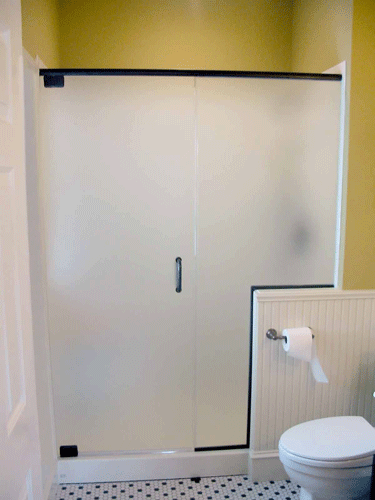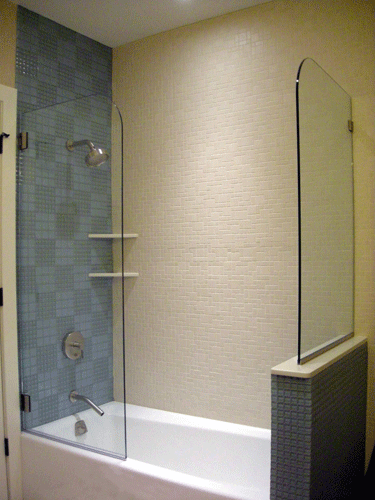Preparing for a Heavy Glass Shower
This is a guide to enable you to prepare for a safe and cost effective heavy glass shower installation.
- Doors and Hinges - Every door hinge has a manufacturer required weight and width restriction. For example, a pair of "Geneva" style hinges have a maximum door width of 28" and a maximum door weight of 80lbs. A pair of "Vienna" style hinges have a maximum door width of 36" and a maximum door weight of 110lbs.
-
Wall Mounted Door Hinges
 - Manufacturers require that the hinges be fastened thru the tile and into wood blocking. We recommend that solid wood blocking be installed vertically at least to the top of the enclosure and to the full width of the sill. The wall that the hinges are to be mounted to must be straight (i.e. it can not bow in or out) so that the pivot point of each hinge is in alignment. The wall does not have to be plumb, but it must be straight.
- Manufacturers require that the hinges be fastened thru the tile and into wood blocking. We recommend that solid wood blocking be installed vertically at least to the top of the enclosure and to the full width of the sill. The wall that the hinges are to be mounted to must be straight (i.e. it can not bow in or out) so that the pivot point of each hinge is in alignment. The wall does not have to be plumb, but it must be straight. - Hinges Mounted Off Sidelites - A door can be hinged off of a fixed sidelite panel that is not supported at the top when the fixed panel is 1/2" thick and is 22" wide or less. The sidelite must also have hinge sized L-shaped wall clamps at same heights as hinges. Otherwise the panel must either be secured to the ceiling, or it must be secured with a header bar.
- Glass Sidelites - For safety reasons, all sidelites must be mechanically fastened in the opening with channel or clamps.
- Sill - The sill or curb must be pitched into the shower to drain water properly. If the sill is almost flat or slopes out slightly the shower enclosure will leak unless a threshold is used to try and create a dam. Remember to remove shipping bars from solid sills and fill the void with thin set to avoid cracking of the sill when drilled. Corner enclosures should use standard angles of 90 degrees or 135 degrees if possible. Other angles are possible but will typically be more expensive.
- Buttress Wall - The face of the buttress wall should always be at 90 degrees to the sill. Angles other than 90 degrees are always much more difficult to enclose. In a door opening, the buttress wall must be plumb so that the door will align to the glass panel sitting on top of the buttress, otherwise the panel must be notched and extended down to the sill to provide a plumb vertical joint to the door, but also reducing the opening width available for the door.
- Seats or Benches - Seats inside the shower enclosure should be sloped down towards the shower base for water runoff and panning should be used to prevent water leakage through the tile.
- Soffits - The footprint of the sill should exactly mirror the footprint of the soffit. Plumb down to ensure that they are the same. If they are not, it will be extremely difficult to align the reveal of the glass to the sill and soffit, and the final product will look horrible.
-
 Steam Units
- Whenever you enclose the shower from sill to soffit you will create a steam enclosure whether you want one or not. Consider an operating pivoting transom above the door or at a sidelite to vent excess steam. We strongly recommend that a fan be installed inside the shower enclosure. The ceiling must be tiled and should extend past the edge of the enclosure.
Steam Units
- Whenever you enclose the shower from sill to soffit you will create a steam enclosure whether you want one or not. Consider an operating pivoting transom above the door or at a sidelite to vent excess steam. We strongly recommend that a fan be installed inside the shower enclosure. The ceiling must be tiled and should extend past the edge of the enclosure. - Panel Sizes - Never design an enclosure with glass panels narrower than 4" wide. The minimum width of tempered glass is 4". The maximum size of a glass panel depends on the accessibility to the shower enclosure, taking into consideration, narrow stairways, low ceilings etc.
- Raised Decorative Tiles - If you are mounting a door on a wall that has raised tiles, you must notch the tile or install a flat tile at the entire door swing area where the decorative tile would come in contact with the glass. If you have a fixed glass panel butting to the raised tile, you should notch the tile slightly wider than the thickness of the panel.
- Leaks - Please remember that no shower enclosure is water proof. The smaller your shower surround and the closer the shower head is to any moving parts such as swing doors or moving panels, the greater the chance that water will find its way out, over and around such moving parts. Water may also end up on the floor when the sill is not pitched sufficiently, or where walls abutting a door bow away from or into the door. Shower heads and body sprays should never be placed facing the door.
- These simple suggestions will help you avoid the potential traps that make the shower enclosure installation more expensive and/or impossible to build as planned. Should you have any questions or concerns please do not hesitate to contact us. We want you to be satisfied with our work !

